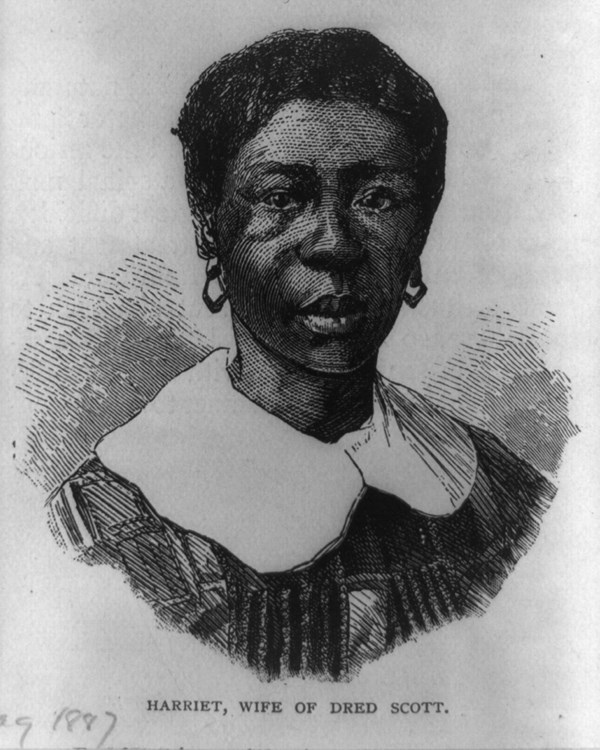Last updated: April 8, 2021
Person
Harriet Robinson Scott

https://www.loc.gov/pictures/resource/cph.3a08392/
Harriet Robinson Scott was an enslaved woman whose determination to free herself and her family made history. She and her husband, Dred Scott, spent years living in free territory in what is now Minnesota. In the 1840s, the Scotts sued for their freedom in Missouri. Their case made its way to the Supreme Court. In 1857, the Court ruled against the family. Dred Scott v. Sandford hastened the outbreak of the U.S. Civil War. Historians regard it as one of the worst and most consequential Court rulings in U.S. history.
Slavery at Fort Snelling
Harriet Robinson was born enslaved in Virginia around 1815. In the early 1830s her enslaver, Lawrence Taliaferro, brought her to Fort Snelling in what was then the Northwest Territory.[1] Slavery was illegal there. But it was common for military officers to break the law by bringing enslaved people with them when they were reassigned to different postings.
In 1836, the man who would become Robinson’s husband arrived: Dred Scott. Scott and Robinson met and married in 1836 or 1837. Although the government did not legally recognize marriages among enslaved people, Taliaferro united the couple in a civil ceremony. He transferred ownership of Harriet Scott to Dred Scott’s owner, a military surgeon named John Emerson.
Over the next few years, Emerson moved the Scotts back and forth between free and slave territory. Their residence in free areas would become the centerpiece of their legal cases. At times, Emerson and his new wife, Eliza Irene Sanford, leased the Scotts out as hired slaves. They would work for other employers, and the Emersons would take their wages. Harriet probably worked doing laundry, cleaning houses, and caring for children. During one trip between Louisiana and Minnesota, Harriet gave birth her first daughter, Eliza, on a steamboat on the Mississippi River. A few years later Harriet had another daughter, Lizzie. In 1843, John Emerson died, and left the Scotts to his wife. She sent them back to St. Louis from Fort Snelling, where they were again hired out to work for other people.
Freedom Suits
Three years later, Harriet and Dred Scott determined that they would to take action to win their freedom. They filed separate petitions in the St. Louis Circuit Court.[2] Their cases rested on their residence at Fort Snelling, in free territory. Several free states had laws on the books that held that if an enslaved person lived there for a certain length of time with their owner’s permission—as both Scotts had done—they would become free.Other enslaved people had claimed their freedom in this way. The Scotts likely received advice from John R. Anderson, the pastor at the church Harriet attended. Their lawyers offered evidence that Dred Scott had been treated as a free man while living at Fort Snelling. They pointed out that Lawrence Taliaferro had performed a civil marriage ceremony for the couple.The cases wended their way through the court system, and the Scotts endured years of delays and multiple appeals. In 1850, their lawyers decided to merge their two petitions into one, and Harriet’s name was dropped in favor of her husband’s.
Dred Scott v. Sandford
Finally, in 1857, the case, now titled Dred Scott v. Sandford, reached the US Supreme Court. Chief Justice Roger Taney wrote the majority opinion. He argued that the framers of the Constitution had believed that Black people had “no rights which the white man was bound to respect.” Enslaved or free, he ruled, Black people were not citizens of the United States. Dred Scott and other Black people therefore had no right to bring freedom suits.The Court also struck down the Missouri Compromise, which had banned slavery in most northern states and territories while allowing new areas in the South to enter the union as slave states. The decision contributed to the start of the American Civil War four years later.
Freedom for the Scotts
The loss of their case was a devastating setback, but the Scotts gained their freedom a few months later. Their owner—by then Taylor Blow—freed them on May 26, 1857. Dred Scott died of tuberculosis less than a year later. Harriet Robinson Scott remained in St. Louis as a free woman. She worked as a laundress for many years. She died at the age of 61 on June 17, 1876 and was buried in Greenwood Cemetery, one of the first Black burial grounds in the city. Although her name is not as well-known as her husband’s, her drive to secure freedom for herself and her family was equally powerful in changing the course of American history.
Notes
[1] Historic Fort Snelling is now part of the Mississippi National River and Recreation Area. It was designated a National Historic Landmark on December 19, 1960.[2] The first two trials of the case took place at the Old Courthouse in St. Louis, now part of Gateway Arch National Historic Site. It was added to the National Register of Historic Places on October 15, 1966. This site is also part of the NPS’s National Underground Railroad Network to Freedom.
Bibliography
“Harriet Robinson Scott.” Historic Missourians. The State Historical Society of Missouri, https://historicmissourians.shsmo.org/historicmissourians/name/s/scotth/.
Jones, Martha. Birthright Citizens: A History of Race and Rights in Antebellum America. New York: Cambridge University Press, 2018.
“March 6, 1857: Dred (and Harriet) Scott Decision.” Zinn Education Project. https://www.zinnedproject.org/news/tdih/dred-harriet-scott-decision/.
VanderVelde, Lea. Mrs. Dred Scott: A Life on Slavery’s Frontier. New York: Oxford University Press, 2009.
This article is excerpted from the collection "Women of the Mississippi River", created in 2020 by Mississippi Park Connection, a partner of the Mississippi National River and Recreation Area.
Article by Ella Wagner, Cultural Resources Office of Interpretation and Education.
